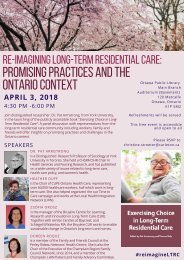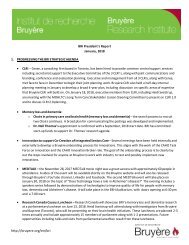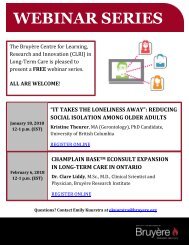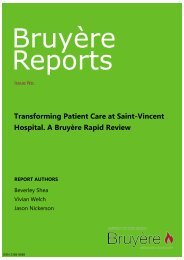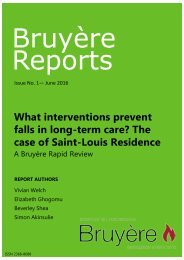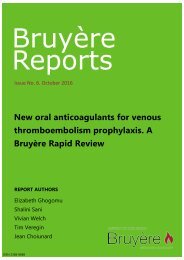Using Concept Mapping to Build Coordinated, Person-centered, High-quality Care at Saint-Vincent Hospital: Summary of Evidence
You also want an ePaper? Increase the reach of your titles
YUMPU automatically turns print PDFs into web optimized ePapers that Google loves.
Bruyère<br />
Reports<br />
Issue No. 2. February 2016<br />
<strong>Using</strong> <strong>Concept</strong> <strong>Mapping</strong> <strong>to</strong> <strong>Build</strong> <strong>Coordin<strong>at</strong>ed</strong>,<br />
<strong>Person</strong>-centred, <strong>High</strong>-<strong>quality</strong> <strong>Care</strong> <strong>at</strong><br />
<strong>Saint</strong>-<strong>Vincent</strong> <strong>Hospital</strong>: <strong>Summary</strong> <strong>of</strong> <strong>Evidence</strong>,<br />
August, 2014<br />
REPORT AUTHORS<br />
Beverley Shea<br />
Sandra Schmidt<br />
Vivian Welch<br />
Jason Nickerson<br />
ISSN 2368-8688
2
Contents<br />
Executive <strong>Summary</strong> 4<br />
Theme 1 Communic<strong>at</strong>ion and Understanding (Direction <strong>to</strong>ward Sub-Acute <strong>Care</strong> 6<br />
Theme 2 Safety 7<br />
Theme 3 Equipment and Infrastructure 8<br />
Theme 4 Funding 9<br />
Theme 5 <strong>Person</strong>-Centred <strong>Care</strong> (Including Improved Communic<strong>at</strong>ions) 10<br />
Theme 6 <strong>Coordin<strong>at</strong>ed</strong> <strong>Care</strong> (Inter– and Intrapr<strong>of</strong>essional Collabor<strong>at</strong>ion) 11<br />
Theme 7 Accountability (Respect and Emp<strong>at</strong>hy) 12<br />
Theme 8 <strong>Care</strong> <strong>at</strong> Transitions (Admissions, Discharges and Transfers) 13<br />
Theme 9 Clinical Outcomes (Establish <strong>Person</strong>-Centred Outcomes) 14<br />
Theme 10 Culture <strong>of</strong> Learning (Educ<strong>at</strong>ion and Men<strong>to</strong>rship) 14<br />
Theme 11 Hiring and Management 16<br />
Theme 12 Organiz<strong>at</strong>ional Support 17<br />
References 17<br />
Key message<br />
The p<strong>at</strong>ient popul<strong>at</strong>ion <strong>at</strong> <strong>Saint</strong>-<strong>Vincent</strong> <strong>Hospital</strong> (SVH)<br />
has changed with medically complex p<strong>at</strong>ients admitted<br />
for short-term sub-acute care instead <strong>of</strong> longterm<br />
care. To ensure th<strong>at</strong> the care it provides continues <strong>to</strong><br />
be commensur<strong>at</strong>e with the needs <strong>of</strong> its p<strong>at</strong>ients, the<br />
‘Transforming the P<strong>at</strong>ient <strong>Care</strong> Experience’ project was<br />
launched in partnership with the Bruyère Research<br />
Institute (BRI), <strong>to</strong> understand the experience <strong>of</strong> care <strong>at</strong><br />
the bedside and during care transitions. Six stakeholder<br />
groups <strong>to</strong>ok part in concept-mapping exercises <strong>to</strong><br />
identify and prioritize themes. The main objective <strong>of</strong><br />
the concept-mapping sessions was <strong>to</strong> identify local<br />
person-focused indica<strong>to</strong>rs <strong>to</strong> help with the development<br />
<strong>of</strong> an instrument th<strong>at</strong> would measure the p<strong>at</strong>ient<br />
and family experience <strong>at</strong> SVH.<br />
Based on the concept mapping sessions, 12 themes<br />
were identified: Communic<strong>at</strong>ion and Understanding;<br />
Safety; Equipment and Infrastructure; Funding; <strong>Person</strong><br />
-centred <strong>Care</strong>; <strong>Coordin<strong>at</strong>ed</strong> <strong>Care</strong>; Accountability; <strong>Care</strong><br />
<strong>at</strong> Transitions; Clinical Outcomes; Culture <strong>of</strong> Learning;<br />
Hiring and Management; Organiz<strong>at</strong>ional Support.<br />
3
Executive <strong>Summary</strong><br />
Context<br />
<strong>Saint</strong>-<strong>Vincent</strong> <strong>Hospital</strong> is a 336-bed Complex Continuing<br />
<strong>Care</strong>* (CCC) hospital affili<strong>at</strong>ed with Bruyère Continuing<br />
<strong>Care</strong>. <strong>Saint</strong>-<strong>Vincent</strong> provides care <strong>to</strong> a broad<br />
range <strong>of</strong> p<strong>at</strong>ients with complex medical and social<br />
needs through the services <strong>of</strong> an interpr<strong>of</strong>essional care<br />
team. <strong>Saint</strong>-<strong>Vincent</strong> <strong>Hospital</strong> is the sole provider <strong>of</strong><br />
Complex Continuing <strong>Care</strong> in the Ottawa region.<br />
The p<strong>at</strong>ient popul<strong>at</strong>ion <strong>at</strong> <strong>Saint</strong>-<strong>Vincent</strong> <strong>Hospital</strong> (SVH)<br />
has changed dram<strong>at</strong>ically over the last five years. As<br />
more medically complex p<strong>at</strong>ients are admitted for<br />
short-term sub-acute care instead <strong>of</strong> long-term care,<br />
the average length <strong>of</strong> stay has steadily dropped. In<br />
light <strong>of</strong> this system<strong>at</strong>ic change, the hospital needs <strong>to</strong><br />
ensure th<strong>at</strong> the care it provides continues <strong>to</strong> be commensur<strong>at</strong>e<br />
with the needs <strong>of</strong> its p<strong>at</strong>ients. The<br />
‘Transforming the P<strong>at</strong>ient <strong>Care</strong> Experience’ project was<br />
initi<strong>at</strong>ed in December 2013 <strong>to</strong> assist with this transition.<br />
A partnership between Bruyère Continuing <strong>Care</strong> and<br />
the Bruyère Research Institute (BRI), the ‘Transforming<br />
the P<strong>at</strong>ient <strong>Care</strong> Experience’ project aims <strong>to</strong> understand<br />
the experience <strong>of</strong> care <strong>at</strong> the bedside and during<br />
care transitions. This research incorpor<strong>at</strong>es perspectives<br />
from the p<strong>at</strong>ients, their families, and their care<br />
providers. This report provides a summary <strong>of</strong> inputs<br />
from six key stakeholder groups: p<strong>at</strong>ients, p<strong>at</strong>ient families,<br />
managers and direc<strong>to</strong>rs, nurses, allied health<br />
pr<strong>of</strong>essionals, and physicians.<br />
Methods<br />
To better understand the evolving issues facing SVH,<br />
investiga<strong>to</strong>rs chose <strong>to</strong> structure stakeholder groups<br />
with represent<strong>at</strong>ives from each <strong>of</strong> the six key stakeholder<br />
groups as listed above.<br />
Overall Recommend<strong>at</strong>ions<br />
The following recommend<strong>at</strong>ions are based directly on<br />
our concept-mapping sessions:<br />
1. SVH should develop and implement an educ<strong>at</strong>ional<br />
safety program for all staff, volunteers,<br />
p<strong>at</strong>ients, and families <strong>to</strong> ensure high-<strong>quality</strong><br />
care. This stems from SVHs’ organiz<strong>at</strong>ional<br />
commitment <strong>to</strong> provide kind and safe care <strong>to</strong><br />
all p<strong>at</strong>ients.<br />
2. SVH should implement an effective equipment<br />
-maintenance program <strong>to</strong> prevent breakdowns<br />
and <strong>to</strong> extend the lifespan <strong>of</strong> expensive equipment.<br />
3. Funding should be p<strong>at</strong>ient-based, and should<br />
rel<strong>at</strong>e directly <strong>to</strong> p<strong>at</strong>ient needs and acuity <strong>to</strong><br />
provide kind and safe care.<br />
4. SVH should focus on establishing a welcoming,<br />
healthy, safe, and stimul<strong>at</strong>ing environment<br />
for p<strong>at</strong>ients and their families.<br />
5. SVH should explore opportunities <strong>to</strong> establish<br />
partnerships both within and between clinical<br />
disciplines. Through coordin<strong>at</strong>ed care, SVH<br />
could elimin<strong>at</strong>e gaps in p<strong>at</strong>ients’ medical, social,<br />
developmental, behavioural, and educ<strong>at</strong>ional<br />
support systems. SVH should develop<br />
and consolid<strong>at</strong>e procedures and checklists <strong>to</strong><br />
address the lack <strong>of</strong> standardiz<strong>at</strong>ion and consistency<br />
<strong>of</strong> care <strong>at</strong> transitions. Discussion <strong>of</strong><br />
this issue should continue, as there were a<br />
number <strong>of</strong> potential solutions suggested by<br />
participants th<strong>at</strong> warrant further explor<strong>at</strong>ion.<br />
6. SVH should develop a local retention str<strong>at</strong>egy<br />
<strong>to</strong> improve its retention <strong>of</strong> high-performing<br />
staff <strong>at</strong> all levels.<br />
These groups <strong>to</strong>ok part in concept-mapping** exercises<br />
<strong>to</strong> identify and prioritize themes. The main objective<br />
<strong>of</strong> the concept-mapping sessions was <strong>to</strong> identify local<br />
person-focused indica<strong>to</strong>rs <strong>to</strong> help with the development<br />
<strong>of</strong> an instrument th<strong>at</strong> would measure the p<strong>at</strong>ient<br />
and family experience <strong>at</strong> SVH.<br />
4
Notes<br />
Each section <strong>of</strong> this document covers a theme<br />
identified during the stakeholder group conceptmapping<br />
sessions which were carried out in early<br />
2014. The red text box th<strong>at</strong> concludes each section<br />
provides a summary.<br />
Each section lists the priorities th<strong>at</strong> focus-group<br />
participants identified during the concept mapping<br />
sessions. All <strong>of</strong> the listed priorities were r<strong>at</strong>ed in<br />
terms <strong>of</strong> the issue’s influence on the clinical environment<br />
provided <strong>at</strong> SVH. Priorities with a r<strong>at</strong>ing<br />
<strong>of</strong> ‘strong’, ‘very strong’, and ‘very, very strong’ are<br />
included in this report.<br />
For each priority, the stakeholder group(s) th<strong>at</strong><br />
identified the priority is also listed. “All” indic<strong>at</strong>es<br />
th<strong>at</strong> all <strong>of</strong> the stakeholder groups considered the<br />
issue ‘strong’, ‘very strong’, or ‘very, very strong’.<br />
Stakeholders<br />
P<strong>at</strong>ients<br />
P<strong>at</strong>ient families<br />
Managers and direc<strong>to</strong>rs<br />
Nurses<br />
Allied health pr<strong>of</strong>essionals<br />
Physicians<br />
Question asked <strong>to</strong> stakeholder group participants<br />
“Wh<strong>at</strong> intervention/solution would you suggest or recommend<br />
<strong>to</strong> improve the <strong>quality</strong> <strong>of</strong> care <strong>at</strong> SVH?”<br />
*Complex continuing care (CCC) provides continuing, medically<br />
complex, and specialized services <strong>to</strong> both young and<br />
old, sometimes over extended periods <strong>of</strong> time. CCC is provided<br />
in hospitals for people who have long-term illnesses or<br />
disabilities typically requiring skilled, technology-based care<br />
not available <strong>at</strong> home or in long-term care facilities. CCC<br />
provides p<strong>at</strong>ients ith room, board, and other necessities in<br />
addition <strong>to</strong> medical care.<br />
**<strong>Concept</strong> maps are graphical <strong>to</strong>ols used <strong>to</strong> organize and<br />
represent knowledge and the rel<strong>at</strong>ionships between concepts.<br />
<strong>Concept</strong> mapping is applied as a group-decision support<br />
<strong>to</strong>ol <strong>to</strong> understand the complexity <strong>of</strong> fac<strong>to</strong>rs contributing<br />
<strong>to</strong> a particular outcome or decision.<br />
5
Theme 1: Communic<strong>at</strong>ion and<br />
Understanding<br />
(Direction <strong>to</strong>ward Sub-Acute <strong>Care</strong>)<br />
Participant priorities<br />
The following priorities were listed by all stakeholder<br />
groups unless otherwise specified:<br />
Understand the complex care needs <strong>of</strong> SVH p<strong>at</strong>ients.<br />
Clarify SVH’s role in the context <strong>of</strong> a large-scale<br />
healthcare system.<br />
Provide an adequ<strong>at</strong>e description <strong>of</strong> the types <strong>of</strong><br />
services SVH provides when all communic<strong>at</strong>ion<br />
m<strong>at</strong>erials are distributed both internally and externally.<br />
Ensure engagement and transparency with p<strong>at</strong>ients,<br />
families, and caregivers pertaining <strong>to</strong> challenges<br />
and potential for improvement in the communic<strong>at</strong>ion<br />
<strong>of</strong> care activities.<br />
Improve two-way communic<strong>at</strong>ion <strong>at</strong> all organiz<strong>at</strong>ional<br />
levels, from p<strong>at</strong>ients and families through <strong>to</strong><br />
senior leadership (always smiling and displaying a<br />
positive <strong>at</strong>titude).<br />
Nurses: manage care for an increasingly complex<br />
p<strong>at</strong>ient popul<strong>at</strong>ion with multiple health problems.<br />
Allied health pr<strong>of</strong>essionals: better understand and<br />
convey the allied health pr<strong>of</strong>essionals’ collabor<strong>at</strong>ive<br />
role in the provision <strong>of</strong> SVH’s care.<br />
Progress <strong>to</strong> d<strong>at</strong>e<br />
<br />
<br />
<br />
<br />
<br />
<br />
The P<strong>at</strong>ient and Family Advisory Committee will be<br />
initi<strong>at</strong>ed in May 2015.<br />
Partnership with BRI continues through the Canadian<br />
Found<strong>at</strong>ion for Healthcare Improvement’s<br />
(CFHI) ‘Partnering with P<strong>at</strong>ients and Families for<br />
Healthcare Improvement <strong>at</strong> Transitions’ program.<br />
Changes have been implemented in Decision Support<br />
and the admissions process for SVH with the<br />
addition <strong>of</strong> a Bruyère admission coordina<strong>to</strong>r <strong>at</strong> the<br />
Ottawa <strong>Hospital</strong>, Bruyère’s largest p<strong>at</strong>ient referral<br />
source.<br />
To meet the increased complexity <strong>of</strong> care required<br />
by a sub-acute p<strong>at</strong>ient popul<strong>at</strong>ion, the care provider<br />
skill mix has been changed <strong>to</strong> consist predomin<strong>at</strong>ely<br />
<strong>of</strong> registered nurses.<br />
Specialized unit-based orient<strong>at</strong>ion and educ<strong>at</strong>ional<br />
modules have been developed for nurses.<br />
The Nursing Pr<strong>of</strong>essional Practice Team has been<br />
reorganized <strong>to</strong> include nursing practice leaders<br />
and practical support nurses<br />
Recommend<strong>at</strong>ions<br />
<br />
<br />
<br />
<br />
<br />
<br />
<br />
Capitalize on partnerships with BRI for research on<br />
complex continuing care p<strong>at</strong>ient popul<strong>at</strong>ions.<br />
Provide staffing levels th<strong>at</strong> can accommod<strong>at</strong>e p<strong>at</strong>ient<br />
complexity.<br />
Provide educ<strong>at</strong>ional opportunities <strong>to</strong> staff th<strong>at</strong> address<br />
the increasingly complex needs <strong>of</strong> p<strong>at</strong>ients.<br />
Change SVH’s identity and mission <strong>to</strong> those <strong>of</strong> a<br />
sub-acute hospital.<br />
Seek more consistency between the branding <strong>of</strong><br />
SVH and the branding <strong>of</strong> Élisabeth Bruyère <strong>Hospital</strong><br />
(EBH).<br />
Develop a plan <strong>to</strong> improve communic<strong>at</strong>ion <strong>at</strong> SVH<br />
th<strong>at</strong> incorpor<strong>at</strong>es p<strong>at</strong>ient and family input. Implement<br />
the plan and measure its success over a period<br />
<strong>of</strong> two years.<br />
Provide adequ<strong>at</strong>e communic<strong>at</strong>ion m<strong>at</strong>erials <strong>to</strong> facilit<strong>at</strong>e<br />
explaining each staff member’s role.<br />
SVH needs <strong>to</strong> adapt <strong>to</strong> an increasingly acute<br />
p<strong>at</strong>ient popul<strong>at</strong>ion. It must shift its focus <strong>to</strong><br />
providing sub-acute care and maintain clarity<br />
and consistency when branding itself. All<br />
stakeholders emphasized th<strong>at</strong> this change in<br />
direction requires a unified transform<strong>at</strong>ion<br />
and excellent communic<strong>at</strong>ion <strong>at</strong> all organiz<strong>at</strong>ional<br />
levels. All staff and p<strong>at</strong>ients should<br />
know where SVH is headed and wh<strong>at</strong> its<br />
goals are.<br />
6
Theme 2: Safety<br />
Participant priorities<br />
P<strong>at</strong>ients, allied health: answering call bells within<br />
10 -15 minutes.<br />
P<strong>at</strong>ients: ensuring rooms are clean.<br />
Families: caring for p<strong>at</strong>ients during staff breaks.<br />
Families: washing hands regularly.<br />
Nurses: ensuring nursing environments are safe,<br />
particularly against falls.<br />
Nurses: caring for wounds quickly and safely.<br />
Recommend<strong>at</strong>ions<br />
Take advantage <strong>of</strong> Bruyère’s Best <strong>Evidence</strong> Review<br />
Group (BERG) <strong>to</strong> establish an evidence-based program<br />
th<strong>at</strong> addresses safety and <strong>quality</strong> <strong>of</strong> care.<br />
Provide Situ<strong>at</strong>ional Awareness training for staff and<br />
volunteers.<br />
Progress <strong>to</strong> d<strong>at</strong>e<br />
An inven<strong>to</strong>ry <strong>of</strong> all medical equipment has been<br />
completed. All additional supplies have been returned<br />
<strong>to</strong> a central loc<strong>at</strong>ion.<br />
To increase nursing time <strong>at</strong> the bedside, p<strong>at</strong>ient<br />
cupboards have been redesigned <strong>to</strong> hold p<strong>at</strong>ientspecific<br />
supplies.<br />
A prevent<strong>at</strong>ive equipment maintenance program is<br />
now in place. The feasibility <strong>of</strong> using RFID technologies<br />
for loc<strong>at</strong>ing and maintaining equipment is<br />
being explored.<br />
Nursing staff are now able <strong>to</strong> provide point-<strong>of</strong>-care<br />
document<strong>at</strong>ion with the introduction <strong>of</strong> electronic<br />
p<strong>at</strong>ients’ records and workst<strong>at</strong>ions on wheels.<br />
Progress <strong>to</strong> d<strong>at</strong>e<br />
Call bells are now managed by clinical managers <strong>to</strong><br />
ensure all team members answer p<strong>at</strong>ient call bells<br />
in a reasonable timeframe.<br />
We have implemented unit-based <strong>quality</strong> team initi<strong>at</strong>ives<br />
directed <strong>at</strong> improving response time <strong>to</strong> call<br />
bells and improving p<strong>at</strong>ient and family s<strong>at</strong>isfaction<br />
and experience.<br />
Hourly rounding (during which nurses check on<br />
each p<strong>at</strong>ient <strong>to</strong> ensure their comfort and safety)<br />
has been implemented.<br />
<strong>High</strong>er-acuity p<strong>at</strong>ients generally require more<br />
expensive and complic<strong>at</strong>ed equipment. As<br />
the complexity <strong>of</strong> SVH’s p<strong>at</strong>ient popul<strong>at</strong>ion<br />
increases, so <strong>to</strong>o will the demand for equipment<br />
and maintenance. Effective equipment<br />
maintenance programs should be implemented<br />
<strong>to</strong> prevent equipment breakdown and <strong>to</strong><br />
extend the life cycle <strong>of</strong> expensive equipment.<br />
7
Theme 3: Equipment and<br />
Infrastructure<br />
Participant priorities<br />
P<strong>at</strong>ients: fixing equipment regularly <strong>to</strong> prevent<br />
breakdown r<strong>at</strong>her than waiting until the equipment<br />
is dysfunctional.<br />
Allied health pr<strong>of</strong>essionals: ensuring allied health<br />
pr<strong>of</strong>essionals have the supplies they need.<br />
Physicians: devoting more resources <strong>to</strong> purchasing<br />
adequ<strong>at</strong>e equipment for all p<strong>at</strong>ients.<br />
Recommend<strong>at</strong>ions<br />
Reloc<strong>at</strong>e equipment so th<strong>at</strong> it is easily accessible<br />
for prevent<strong>at</strong>ive maintenance. Equipment in nursing<br />
st<strong>at</strong>ions, medic<strong>at</strong>ion rooms, family visiting<br />
rooms, tre<strong>at</strong>ment rooms, supply rooms, staff<br />
lounges, and p<strong>at</strong>ient dining areas is particularly<br />
important.<br />
Ensure each unit has the equipment it needs <strong>to</strong><br />
care for a p<strong>at</strong>ient popul<strong>at</strong>ion with increasingly<br />
complex health needs.<br />
Develop and share an inven<strong>to</strong>ry <strong>of</strong> medical equipment<br />
available across facilities <strong>to</strong> increase accessibility.<br />
Keep central areas tidy and clear <strong>of</strong> equipment.<br />
This requires th<strong>at</strong> all medical equipment be returned<br />
<strong>to</strong> a central area when it is not in use.<br />
Develop and implement Equipment Maintenance<br />
Programs for all equipment belonging <strong>to</strong> longstay<br />
p<strong>at</strong>ients.<br />
Clear guidelines for the cleaning and repair <strong>of</strong><br />
medical equipment th<strong>at</strong> SVH is responsible for.<br />
Progress <strong>to</strong> d<strong>at</strong>e<br />
<br />
<br />
<br />
<br />
An inven<strong>to</strong>ry <strong>of</strong> all medical equipment has been<br />
completed. All additional supplies have been returned<br />
<strong>to</strong> a central loc<strong>at</strong>ion.<br />
To increase nursing time <strong>at</strong> the bedside, p<strong>at</strong>ient<br />
cupboards have been redesigned <strong>to</strong> hold p<strong>at</strong>ientspecific<br />
supplies.<br />
A prevent<strong>at</strong>ive equipment maintenance program<br />
is now in place. The feasibility <strong>of</strong> using RFID technologies<br />
for loc<strong>at</strong>ing and maintaining equipment<br />
is being explored.<br />
Nursing staff are now able <strong>to</strong> provide point-<strong>of</strong>care<br />
document<strong>at</strong>ion with the introduction <strong>of</strong> electronic<br />
p<strong>at</strong>ients’ records and workst<strong>at</strong>ions on<br />
wheels.<br />
<strong>High</strong>er-acuity p<strong>at</strong>ients generally require<br />
more expensive and complic<strong>at</strong>ed equipment.<br />
As the complexity <strong>of</strong> SVH’s p<strong>at</strong>ient<br />
popul<strong>at</strong>ion increases, so <strong>to</strong>o will the demand<br />
for equipment and maintenance.<br />
Effective equipment maintenance programs<br />
should be implemented <strong>to</strong> prevent<br />
equipment breakdown and <strong>to</strong> extend<br />
the life cycle <strong>of</strong> expensive equipment.<br />
8
Theme 4: Funding<br />
Participant priorities<br />
The following priorities were listed by all stakeholder<br />
groups unless otherwise specified:<br />
Alloc<strong>at</strong>ing funding <strong>to</strong> units based on the type and<br />
number <strong>of</strong> p<strong>at</strong>ients they care for.<br />
Funding for forming research partnerships.<br />
Physicians: alloc<strong>at</strong>ing funding <strong>to</strong> improve SVH’s<br />
clinical environment (For example, hiring more<br />
MDs andphysicians` assistants).<br />
Progress <strong>to</strong> d<strong>at</strong>e<br />
To meet the care needs <strong>of</strong> an increasingly complex<br />
p<strong>at</strong>ient popul<strong>at</strong>ion, the Direc<strong>to</strong>r <strong>of</strong> CCC now regularly<br />
performs a review <strong>of</strong> the skill mix p<strong>at</strong>tern on<br />
each unit.<br />
The BERG has been established in partnership with<br />
BRI <strong>to</strong> fund 10 rapid reviews designed <strong>to</strong> improve<br />
the care and services provided <strong>at</strong> Bruyère<br />
Recommend<strong>at</strong>ions<br />
Pursue more internal and external partnerships<br />
with BRI; SVH represents an untapped research<br />
resource.<br />
Alloc<strong>at</strong>e funding in proportion <strong>to</strong> complexity <strong>of</strong><br />
p<strong>at</strong>ient needs and the resources each unit requires<br />
9
Theme 5: <strong>Person</strong>-Centred <strong>Care</strong><br />
(Including Improved Communic<strong>at</strong>ions)<br />
Participant priorities<br />
P<strong>at</strong>ients: involving p<strong>at</strong>ients in calendar planning<br />
and providing desirable food options <strong>to</strong> p<strong>at</strong>ients.<br />
Families, nurses, managers, physicians: taking a<br />
person-centred approach <strong>to</strong> care; explaining r<strong>at</strong>ionale<br />
<strong>to</strong> p<strong>at</strong>ients and asking p<strong>at</strong>ients wh<strong>at</strong> they<br />
need.<br />
Recommend<strong>at</strong>ions<br />
Consider adopting a model <strong>of</strong> care like the one<br />
provided by the Intern<strong>at</strong>ional Alliance for P<strong>at</strong>ients’<br />
Organiz<strong>at</strong>ions (IAPO).1<br />
Receive and incorpor<strong>at</strong>e p<strong>at</strong>ient and family input<br />
when developing relevant programs and policies<br />
Implemente the following changes:<br />
1. require th<strong>at</strong> staff regularly ask p<strong>at</strong>ients<br />
wh<strong>at</strong> their priorities are.<br />
2. institute effective use <strong>of</strong> whiteboards <strong>at</strong><br />
bedsides.<br />
3. introduce hourly <strong>to</strong> two-hourly comfort<br />
rounds for p<strong>at</strong>ients.<br />
4. require th<strong>at</strong> staff perform regular safety<br />
scans <strong>of</strong> their environments.<br />
5. provide more onsite computers for p<strong>at</strong>ient<br />
and family use.<br />
6. make SVH more welcoming by making<br />
use <strong>of</strong> open spaces (i.e. learning resources).<br />
7. provide long-stay p<strong>at</strong>ients with altern<strong>at</strong>ive<br />
activities.<br />
8. reintroduce food menus with more desirable,<br />
healthy food selections.<br />
9. extend the cafeteria’s hours <strong>of</strong> oper<strong>at</strong>ion.<br />
Progress <strong>to</strong> d<strong>at</strong>e<br />
<br />
<br />
<br />
<br />
<br />
<br />
The Three Priorities for <strong>Care</strong> initi<strong>at</strong>ive has been established,<br />
in which p<strong>at</strong>ients and families are asked<br />
<strong>to</strong> identify three specific care activities they would<br />
like <strong>to</strong> be performed each time they are visited by<br />
nursing staff, volunteers, and other hospital staff.<br />
Posters promoting the initi<strong>at</strong>ive have been made<br />
and displayed in each p<strong>at</strong>ient room.<br />
Cus<strong>to</strong>mized “<strong>Care</strong> Boards” have been installed <strong>to</strong><br />
meet the specific needs <strong>of</strong> each p<strong>at</strong>ient and family.<br />
An hourly rounding procedure (<strong>to</strong> assess positioning;<br />
pain; personal items; and <strong>to</strong>ileting) with safety<br />
scans has been implemented.<br />
An additional computer has been added in the<br />
“P<strong>at</strong>h <strong>to</strong> Home Resource Lounge” in the Atrium.<br />
Cafeteria hours have been extended by one hour.<br />
A volunteer-friendly visiting program has been<br />
established <strong>to</strong> improve p<strong>at</strong>ient <strong>quality</strong> <strong>of</strong> life.<br />
All focus groups emphasized the importance<br />
<strong>of</strong> p<strong>at</strong>ient-focused care. SVH<br />
should seek and incorpor<strong>at</strong>e p<strong>at</strong>ient<br />
and family input when developing programs<br />
and policies. SVH should focus<br />
on establishing a welcoming, enjoyable,<br />
and stimul<strong>at</strong>ing environment for<br />
p<strong>at</strong>ients and families.<br />
10
Theme 6: <strong>Coordin<strong>at</strong>ed</strong> <strong>Care</strong><br />
(Inter– and Intra-pr<strong>of</strong>essional Collabor<strong>at</strong>ion)<br />
Participant priorities<br />
Families, nurses: observe an apparent lack <strong>of</strong> team<br />
cooper<strong>at</strong>ion with some nurses and staff.<br />
P<strong>at</strong>ients, families: elimin<strong>at</strong>ing “not-my-p<strong>at</strong>ient”<br />
mentalities.<br />
Nurses: provide more educ<strong>at</strong>ion on workplace<br />
teamwork.<br />
Nurses: developing unit-based mobile teams; assign<br />
casual staff <strong>to</strong> floors; and single managers in<br />
order <strong>to</strong> decentralize the casual pool.<br />
Nurses, allied health, managers: establish interpr<strong>of</strong>essional<br />
collabor<strong>at</strong>ive teams and partnerships.<br />
<br />
<br />
on one floor <strong>at</strong> SVH a successful <strong>quality</strong> improvement<br />
project now mand<strong>at</strong>es hourly rounding. This<br />
has resulted in gre<strong>at</strong>er p<strong>at</strong>ient s<strong>at</strong>isfaction and an<br />
18% decrease in bell usage.<br />
P<strong>at</strong>ients first working group established <strong>to</strong><br />
develop a p<strong>at</strong>ient oriented discharge package,<br />
a web-based frequently asked questions<br />
and take-home discharge placem<strong>at</strong>.<br />
Recommend<strong>at</strong>ions<br />
Review the processes for inter-pr<strong>of</strong>essional collabor<strong>at</strong>ion.<br />
Provide more educ<strong>at</strong>ion <strong>to</strong> staff on ways <strong>to</strong> improve<br />
inter-pr<strong>of</strong>essional collabor<strong>at</strong>ion.<br />
Explore opportunities for ongoing interpr<strong>of</strong>essional<br />
collabor<strong>at</strong>ion as roles change <strong>to</strong><br />
meet the needs <strong>of</strong> an evolving p<strong>at</strong>ient popul<strong>at</strong>ion.<br />
Consider establishing joint appointment partnerships<br />
with universities for allied health, nursing,<br />
and physicians.<br />
All <strong>of</strong> the stakeholder groups emphasized<br />
the importance <strong>of</strong> both intra- and interpr<strong>of</strong>essional<br />
unity and collabor<strong>at</strong>ion. SVH<br />
should explore opportunities <strong>to</strong> establish<br />
partnerships both within and between clinical<br />
disciplines. <strong>Coordin<strong>at</strong>ed</strong> care should<br />
elimin<strong>at</strong>e potential gaps within p<strong>at</strong>ients’<br />
medical, social, developmental, behavioural,<br />
and educ<strong>at</strong>ional support needs 1<br />
Progress <strong>to</strong> d<strong>at</strong>e<br />
Collabor<strong>at</strong>ive inter-pr<strong>of</strong>essional unit <strong>quality</strong> teams<br />
have been established <strong>to</strong> co-design, plan, implement,<br />
and evalu<strong>at</strong>e <strong>quality</strong> improvement initi<strong>at</strong>ives in each<br />
unit. This has resulted in a reduction <strong>of</strong> waste and<br />
gre<strong>at</strong>er efficiency <strong>of</strong> staff. For example,<br />
11
Theme 7: Accountability<br />
(Respect and Emp<strong>at</strong>hy)<br />
Participant priorities<br />
All groups: give and receive respect.<br />
P<strong>at</strong>ients, families, nurses and allied health pr<strong>of</strong>essionals:<br />
ensure staff is accountable for their responsibilities<br />
and decisions.<br />
P<strong>at</strong>ients, families, nurses and allied health pr<strong>of</strong>essionals:<br />
inform staff <strong>of</strong> problems as they arise.<br />
P<strong>at</strong>ients, families, physicians, managers and direc<strong>to</strong>rs:<br />
share knowledge; provide p<strong>at</strong>ients and families<br />
with contacts upon admission.<br />
P<strong>at</strong>ients: ensure nurses, clinicians, and other staff<br />
speaks in the language <strong>of</strong> the p<strong>at</strong>ient or provide<br />
adequ<strong>at</strong>e transl<strong>at</strong>ion services.<br />
Nurses: limit the degree <strong>to</strong> which the GRASP system<br />
increases nursing workload.<br />
Nurses: report more efficiently; nurses spend a<br />
gre<strong>at</strong> deal <strong>of</strong> time on reporting and would like <strong>to</strong><br />
improve efficiency <strong>to</strong> spend more time on direct<br />
p<strong>at</strong>ient care.<br />
Develop and implement a method for reporting on<br />
sub-acute p<strong>at</strong>ients th<strong>at</strong> best communic<strong>at</strong>es outcomes<br />
relevant <strong>to</strong> p<strong>at</strong>ient and family goals.<br />
Progress <strong>to</strong> d<strong>at</strong>e<br />
The clinical manager and allied health <strong>of</strong>fices are<br />
now easily accessible <strong>to</strong> p<strong>at</strong>ients and families on<br />
each unit.<br />
The clinical manager is now the primary contact<br />
person <strong>to</strong> manage concerns, complaints, and compliments.<br />
The electronic p<strong>at</strong>ient record (EPR) has been established<br />
and has standardized assessments, processes,<br />
and reporting throughout all clinical units.<br />
As <strong>of</strong> the EPR “Go Live” d<strong>at</strong>e on April 20, 2015, all<br />
document<strong>at</strong>ion will be accessible and integr<strong>at</strong>ed.<br />
GRASP has been integr<strong>at</strong>ed in<strong>to</strong> the EPR and is no<br />
longer a stand-alone task for the care team <strong>to</strong><br />
complete.<br />
<br />
Allied health pr<strong>of</strong>essionals: consider more collabor<strong>at</strong>ive<br />
sharing <strong>of</strong> d<strong>at</strong>a and p<strong>at</strong>ient inform<strong>at</strong>ion<br />
among team members.<br />
Recommend<strong>at</strong>ions<br />
Share system-wide d<strong>at</strong>a rel<strong>at</strong>ed <strong>to</strong> errors and nearmisses.<br />
Make unit clinical managers more visible.<br />
Consider implementing a two-way complaints<br />
management system <strong>to</strong> respond <strong>to</strong> p<strong>at</strong>ient and<br />
family complaints.<br />
Educ<strong>at</strong>e staff on cultural safety.<br />
Provide an accessible and detailed explan<strong>at</strong>ion <strong>of</strong><br />
GRASP’s usage and convey the benefits it provides.<br />
Review best-evidence practices for reporting and<br />
standardize reporting for all units.<br />
All stakeholder groups identified the importance<br />
<strong>of</strong> respect. Nurses should be<br />
aware <strong>of</strong> their power over p<strong>at</strong>ients and<br />
the importance <strong>of</strong> respecting the p<strong>at</strong>ient’s<br />
culture.2 Stakeholder groups also emphasized<br />
the importance <strong>of</strong> pr<strong>of</strong>essional accountability;<br />
stakeholder groups tended<br />
<strong>to</strong> prioritize consistent accur<strong>at</strong>e reporting<br />
and sharing d<strong>at</strong>a as a means <strong>of</strong> realizing<br />
accountability.<br />
12
Theme 8: <strong>Care</strong> <strong>at</strong> Transitions<br />
(Admissions, Discharges and Transfers)<br />
Participant priorities<br />
P<strong>at</strong>ients, families, nurses and allied health pr<strong>of</strong>essionals:<br />
standardize admission and discharge processes<br />
across the organiz<strong>at</strong>ion and ensure consistency<br />
<strong>at</strong> all internal and external p<strong>at</strong>ient appointments.<br />
P<strong>at</strong>ients and families: address the needs and desires<br />
<strong>of</strong> all p<strong>at</strong>ients (recruit a volunteer ambassador<br />
<strong>to</strong> assist with transitions).<br />
Managers and direc<strong>to</strong>rs: require th<strong>at</strong> nurses who<br />
carry out admission procedures possess adequ<strong>at</strong>e<br />
clinical expertise.<br />
Managers and direc<strong>to</strong>rs: develop an appropri<strong>at</strong>e<br />
intake process so th<strong>at</strong> there is an opportunity <strong>to</strong><br />
refuse inappropri<strong>at</strong>e admissions.<br />
Physicians, managers and direc<strong>to</strong>rs,: reduce the<br />
number <strong>of</strong> transfers out th<strong>at</strong> occur for non-medical<br />
reasons.<br />
Physicians: improve communic<strong>at</strong>ion with nurses,<br />
allied health, and other physicians.<br />
Progress <strong>to</strong> d<strong>at</strong>e<br />
The CFHI ‘Partnering with P<strong>at</strong>ients and Families <strong>at</strong><br />
<strong>Care</strong> Transitions’ program has been established<br />
with multiple p<strong>at</strong>ient and family centred initi<strong>at</strong>ives.<br />
Two transitions coordina<strong>to</strong>rs have been hired <strong>at</strong><br />
each site <strong>of</strong> the Ottawa <strong>Hospital</strong> <strong>to</strong> assist with the<br />
admissions process.<br />
The volunteer ambassador role has been cre<strong>at</strong>ed<br />
<strong>to</strong> assist with transitions.<br />
Checklists for transitions have been developed for<br />
roles involved in p<strong>at</strong>ient transition.<br />
Admission, transfer, and discharge pro<strong>to</strong>cols have<br />
been built in<strong>to</strong> the EPR.<br />
Stakeholder groups have been involved in streamlining<br />
the admission and discharge processes <strong>to</strong><br />
improve efficiency and p<strong>at</strong>ient flow.<br />
All transfers for non-clinical reasons must now be<br />
approved by the Direc<strong>to</strong>r <strong>of</strong> CCC.<br />
The new manager for p<strong>at</strong>ient flow has been appointed.<br />
Recommend<strong>at</strong>ions<br />
Develop standard p<strong>at</strong>ient-centred pro<strong>to</strong>cols for all<br />
admissions, transfers, and discharges.<br />
<br />
The ’P<strong>at</strong>h <strong>to</strong> Home Resource Lounge‘ has been initi<strong>at</strong>ed<br />
<strong>to</strong> provide discharge inform<strong>at</strong>ion for p<strong>at</strong>ients, families<br />
and staff.<br />
<br />
<br />
<br />
<br />
<br />
Hire a nursing admissions coordina<strong>to</strong>r <strong>to</strong> ensure<br />
th<strong>at</strong> all admission requirements are met.<br />
Develop checklists for room prepar<strong>at</strong>ion upon admission,<br />
transfer, and discharge.<br />
Consolid<strong>at</strong>e the checklists for admissions, transfers,<br />
and discharges.<br />
Minimize the number <strong>of</strong> p<strong>at</strong>ient transfers motiv<strong>at</strong>ed<br />
by nonclinical fac<strong>to</strong>rs.<br />
Develop and implement a formal and efficient program<br />
for internal and external transfers.<br />
Stakeholder group participants identified<br />
several barriers th<strong>at</strong> prevent efficient admissions,<br />
transfers and discharges. SVH<br />
should develop and consolid<strong>at</strong>e procedures<br />
and checklists <strong>to</strong> address the lack <strong>of</strong><br />
standardiz<strong>at</strong>ion and consistency <strong>of</strong> care <strong>at</strong><br />
transitions. Discussion <strong>of</strong> this issue should<br />
continue, as there were a number <strong>of</strong> potential<br />
solutions suggested by participants<br />
th<strong>at</strong> warrant further explor<strong>at</strong>ion.<br />
13
Theme 9: Clinical outcomes<br />
(Establish person-centred outcomes)<br />
Participant priorities<br />
<br />
<br />
<br />
P<strong>at</strong>ients: ensure th<strong>at</strong> staff members identify<br />
themselves <strong>to</strong> p<strong>at</strong>ients.<br />
Managers and direc<strong>to</strong>rs: adjust SVH’s healthcare<br />
workers <strong>to</strong> the increasing acuity and complexity<br />
<strong>of</strong> p<strong>at</strong>ients; a different skill mix <strong>of</strong> expertise may<br />
be required (e.g. adopting a complement <strong>of</strong> registered<br />
RNs and RPNs).<br />
Physicians: assess the per-individual workload<br />
presently faced by allied health.<br />
Recommend<strong>at</strong>ions<br />
<br />
<br />
Consider developing person-centred clinical<br />
p<strong>at</strong>hways for specialized programs.<br />
Co-design with p<strong>at</strong>ients and families when developing<br />
clinical p<strong>at</strong>hways.<br />
Progress <strong>to</strong> d<strong>at</strong>e<br />
<br />
<br />
<br />
Work is underway <strong>to</strong> oper<strong>at</strong>ionalize the ideas<br />
brought forth during the Discharge Kaizen<br />
(Japanese for “change for the better”) Event th<strong>at</strong><br />
was held as part <strong>of</strong> the work with CFHI’s<br />
‘Partnering with P<strong>at</strong>ients and Families for<br />
Healthcare Improvement’ program.<br />
Work is underway <strong>to</strong> co-design clinical miles<strong>to</strong>nes<br />
within the rehabilit<strong>at</strong>ion programs. These miles<strong>to</strong>nes<br />
can be recognized and celebr<strong>at</strong>ed with<br />
p<strong>at</strong>ients and families.<br />
Inform<strong>at</strong>ion <strong>to</strong> prepare for discharge would begin<br />
<strong>at</strong> the time <strong>of</strong> admission and would be provided<br />
<strong>at</strong> specific miles<strong>to</strong>nes. Inform<strong>at</strong>ion will pertain <strong>to</strong><br />
community resources, falls prevention, evidencebased<br />
practices <strong>to</strong> self-manage chronic diseases,<br />
and a new person-centred discharge kit for safety<br />
consider<strong>at</strong>ions.<br />
Theme 10: Culture and learning<br />
(Educ<strong>at</strong>ion and men<strong>to</strong>rship)<br />
Participant priorities<br />
<br />
<br />
<br />
<br />
P<strong>at</strong>ients: ensure physicians listen carefully <strong>to</strong> p<strong>at</strong>ients<br />
and pass on their inform<strong>at</strong>ion <strong>to</strong> the care<br />
team.<br />
P<strong>at</strong>ients and families: provide learning opportunities<br />
and training for staff, volunteers, p<strong>at</strong>ients and<br />
families.<br />
Families and nurses: provide approved pr<strong>of</strong>essional<br />
development activities for staff. • Nurses:<br />
provide men<strong>to</strong>rship for staff.<br />
Nurses and allied health pr<strong>of</strong>essionals: provide<br />
inhouse educ<strong>at</strong>ional opportunities.<br />
<br />
<br />
Physicians, managers and direc<strong>to</strong>rs: provide more<br />
educ<strong>at</strong>ion and resources <strong>to</strong> p<strong>at</strong>ients, families, and<br />
the pr<strong>of</strong>essional care team.<br />
Physicians: look <strong>at</strong> str<strong>at</strong>egies <strong>to</strong> work in partnership<br />
with the physician groups <strong>to</strong> develop criteria<br />
and processes <strong>to</strong> facilit<strong>at</strong>e the efficient use <strong>of</strong><br />
physician expertise.<br />
Recommend<strong>at</strong>ions<br />
<br />
Improve nurses’ and allied health pr<strong>of</strong>essionals’<br />
access <strong>to</strong> educ<strong>at</strong>ional sessions.<br />
14
Progress <strong>to</strong> d<strong>at</strong>e<br />
<br />
<br />
<br />
<br />
A P<strong>at</strong>ient and Family Advisory Committee has<br />
been establihed <strong>to</strong> develop, plan, implement, and<br />
evalu<strong>at</strong>e p<strong>at</strong>ient-centred activities, including educ<strong>at</strong>ional<br />
opportunities.<br />
Online e-learning modules are being developed<br />
by the Bruyère learning department, which staff<br />
can access <strong>at</strong> any time.<br />
The new Direc<strong>to</strong>rs <strong>of</strong> Nursing Pr<strong>of</strong>essional Practice,<br />
Nursing Pr<strong>of</strong>essional Practice Leaders, and<br />
Nursing Practice Nurses are now on each unit <strong>to</strong><br />
provide scheduled and just-in-time educ<strong>at</strong>ional<br />
opportunities.<br />
Unit Quality Teams coached by continuous <strong>quality</strong>-improvement<br />
Green Belts (from within the organiz<strong>at</strong>ion)<br />
and led by Health Quality Ontario<br />
facilita<strong>to</strong>rs (clinical managers) now provide continual<br />
learning <strong>to</strong> inter-pr<strong>of</strong>essional teams<br />
(including physicians, p<strong>at</strong>ients, and families) and<br />
particip<strong>at</strong>e in <strong>quality</strong>-improvement initi<strong>at</strong>ives and<br />
projects At each unit level.<br />
All focus groups identified educ<strong>at</strong>ion and<br />
training as a priority. SVH should focus<br />
on providing more accessible educ<strong>at</strong>ional<br />
opportunities as part <strong>of</strong> a continuing pr<strong>of</strong>essional<br />
development program.<br />
15
Theme 11: Hiring and management<br />
Participant priorities<br />
<br />
<br />
<br />
<br />
<br />
<br />
<br />
All groups: retain talented staff.<br />
P<strong>at</strong>ients, families, nurses and allied health pr<strong>of</strong>essionals:<br />
post and distribute job opportunities.<br />
P<strong>at</strong>ients: assess volunteer performance. • Families:<br />
ensure staff follow dress codes.<br />
Families: ensure staff name tags are worn <strong>at</strong> all times<br />
and are large-print.<br />
Nurses: provide a mix <strong>of</strong> 12-hour and 8-hour shifts.<br />
Allied health pr<strong>of</strong>essionals: increase the number <strong>of</strong> on<br />
-site physicians.<br />
Physicians: ensure managers have had experience as<br />
nurses.<br />
Recommend<strong>at</strong>ions<br />
<br />
<br />
<br />
<br />
<br />
<br />
Develop and implement easy-<strong>to</strong>-use and efficient<br />
hiring <strong>to</strong>ols.<br />
Develop and implement a program <strong>to</strong> retain talented<br />
staff. • Conduct exit interviews with staff.<br />
Implement a stricter dress code and redesign name<br />
tags <strong>to</strong> ensure legibility.<br />
Allow family members <strong>to</strong> become true partners in<br />
care.<br />
Develop assessment <strong>to</strong>ols for volunteers.<br />
Pursue the adoption <strong>of</strong> 12-hour shifts.<br />
Progress <strong>to</strong> d<strong>at</strong>e<br />
<br />
<br />
<br />
Interview guides th<strong>at</strong> combine behavioural interviewing<br />
with assessment <strong>of</strong> knowledge, skills and <strong>at</strong>titudes<br />
have been developed for all c<strong>at</strong>egories <strong>of</strong> staff<br />
<strong>to</strong> ensure better recruitment and hiring.<br />
A new ‘Leadership Legacy’ program is underway <strong>to</strong><br />
provide executive coaching opportunities for all managers<br />
and senior leaders.<br />
All management staff has now received the Canadian<br />
College <strong>of</strong> Health Leaders (LEADS) in a caring environment<br />
training.<br />
<br />
<br />
<br />
<br />
<br />
All management staff is particip<strong>at</strong>ing in an Individual<br />
Development Plan process with an executive coach.<br />
Dress codes (including having a visible name badge)<br />
have been reinforced for all staff.<br />
Porters now have standardized uniforms.<br />
Planning for the ‘Partners in <strong>Care</strong>’ program – in which<br />
family members are provided with educ<strong>at</strong>ion and<br />
support <strong>to</strong> assist with basic care in prepar<strong>at</strong>ion for<br />
discharge – is underway.<br />
In partnership with the unions, 12-hour shifts are being<br />
introduced. Additional full-time positions are being<br />
cre<strong>at</strong>ed.<br />
All stakeholder groups identified the retention<br />
<strong>of</strong> high-performing staff as a priority.<br />
SVH needs <strong>to</strong> redesign nametags and implement<br />
a stricter dress code policy <strong>to</strong> facilit<strong>at</strong>e<br />
the identific<strong>at</strong>ion <strong>of</strong> staff and their roles. Additionally,<br />
adopting 12-hour shifts may ensure<br />
better continuity <strong>of</strong> care, less staff turnover,<br />
and reduced numbers <strong>of</strong> part-time staff .<br />
16
Theme 12: Organiz<strong>at</strong>ional support<br />
Participant priorities<br />
<br />
<br />
<br />
<br />
<br />
P<strong>at</strong>ients and families: provide support groups for<br />
caregivers.<br />
Nurses: develop a system <strong>to</strong> deal with complaints and<br />
concerns.<br />
Allied health pr<strong>of</strong>essionals, managers and direc<strong>to</strong>rs:<br />
recognize staff burnout.<br />
Physicians, managers and direc<strong>to</strong>rs: provide psychological<br />
support <strong>to</strong> staff, p<strong>at</strong>ients, and families.<br />
Physicians: provide more opportunity for direct physician<br />
interaction with the senior leadership team and<br />
Board <strong>of</strong> Direc<strong>to</strong>rs.<br />
Recommend<strong>at</strong>ions<br />
<br />
<br />
<br />
<br />
Engage staff and caregivers by seeking their input<br />
when developing organiz<strong>at</strong>ional changes.<br />
Provide opportunities for staff <strong>to</strong> provide feedback<br />
on organiz<strong>at</strong>ional changes so they feel their opinions,<br />
voices, and recommend<strong>at</strong>ions are heard and acted<br />
on.<br />
Consider further developing SVH’s physicians’ assistant<br />
program.<br />
Clarify the responsibilities <strong>of</strong> certain clinical staff positions.<br />
Progress <strong>to</strong> d<strong>at</strong>e<br />
<br />
A pilot project with Pas<strong>to</strong>ral <strong>Care</strong> designed <strong>to</strong> provide<br />
support <strong>to</strong> p<strong>at</strong>ients and families has been initi<strong>at</strong>ed.<br />
<br />
<br />
<br />
<br />
<br />
A new complaint process has been developed for<br />
p<strong>at</strong>ients and families, as well as staff.<br />
The ‘Employee Assistance’ program is now in place <strong>to</strong><br />
confidentially assist all staff.<br />
The Direc<strong>to</strong>r <strong>of</strong> Pr<strong>of</strong>essional Practice position and the<br />
Nursing Pr<strong>of</strong>essional Practice Team are now in place<br />
<strong>to</strong> provide educ<strong>at</strong>ion <strong>to</strong> staff.<br />
The Learning department is developing e-learning<br />
modules for all staff available on InfoNet with flexible<br />
accessibility.<br />
The new volunteer ambassador role will provide a<br />
p<strong>at</strong>ient- and family-centred care approach <strong>to</strong> assisting<br />
p<strong>at</strong>ients <strong>at</strong> admission and discharge.<br />
Many focus groups identified staff burnout as<br />
a significant issue.<br />
References<br />
An<strong>to</strong>nelli RC, McAllister JW, Popp J. Making care coordin<strong>at</strong>ion a critical component <strong>of</strong> the pedi<strong>at</strong>ric healthcare<br />
system: a multidisciplinary framework. New York: The Commonwealth Fund; 2009.<br />
Papps E, Ramsden I. Cultural safety in nursing: the New Zealand experience. Int J Qual Health C. 1996 August; 8<br />
(5): 491-497<br />
17
Ongoing work<br />
During the course <strong>of</strong> this initi<strong>at</strong>ive, another project emerged called ‘Three Priorities for <strong>Care</strong>’, which focuses on improving<br />
the p<strong>at</strong>ient experience on Level 5 <strong>at</strong> SVH. This initi<strong>at</strong>ive is p<strong>at</strong>ient-and-family-centred and was developed by a<br />
family member <strong>of</strong> a former p<strong>at</strong>ient.<br />
In collabor<strong>at</strong>ion with BRI, funding was also received from the ‘Partnering with P<strong>at</strong>ients and Families for Healthcare<br />
Improvement Collabor<strong>at</strong>ive’ <strong>to</strong> improve the p<strong>at</strong>ient and family experience <strong>at</strong> transitions. Working within the CFHI Collabor<strong>at</strong>ive,<br />
p<strong>at</strong>ients, families and staff will be further engaged by conveying their s<strong>to</strong>ries and holding Kaizen Events,<br />
which result in promising solution str<strong>at</strong>egies. The Bruyère Kaizen Events will be conducted via rapid improvement cycles<br />
using our unit-based <strong>quality</strong> teams within the Bruyère Quality Framework. Success initi<strong>at</strong>ives will spread throughout<br />
the organiz<strong>at</strong>ion.<br />
Acknowledgements<br />
We wish <strong>to</strong> thank all participants in the concept-mapping sessions. Special thanks go out <strong>to</strong> our p<strong>at</strong>ients, their families,<br />
and caregivers for their time and expert input. Acknowledgement also goes <strong>to</strong> our local research and administr<strong>at</strong>ive<br />
teams, which includes: Dr. John Robinson; Jacqueline Tetro; Alex Cornett; Hilary Ramsay; Elizabeth Ghogomu;<br />
Micere Thuku; Julian Moran; and Debbie Gravelle.<br />
18
Copyright Bruyère Research Institute 2016. This work is licensed under the Cre<strong>at</strong>ive Commons Attribution-<br />
NonCommercial 4.0 Intern<strong>at</strong>ional License. To view a copy <strong>of</strong> this license, visit http://cre<strong>at</strong>ivecommons.org/<br />
licenses/by-nc/4.0/.<br />
Suggested cit<strong>at</strong>ion: Welch V, Ghogomu E, Shea B, Akinsulie S. Wh<strong>at</strong> interventions prevent falls in long-term<br />
care? The case <strong>of</strong> <strong>Saint</strong> Louis Residence. Bruyère Reports No. 1, December 2015.<br />
19



